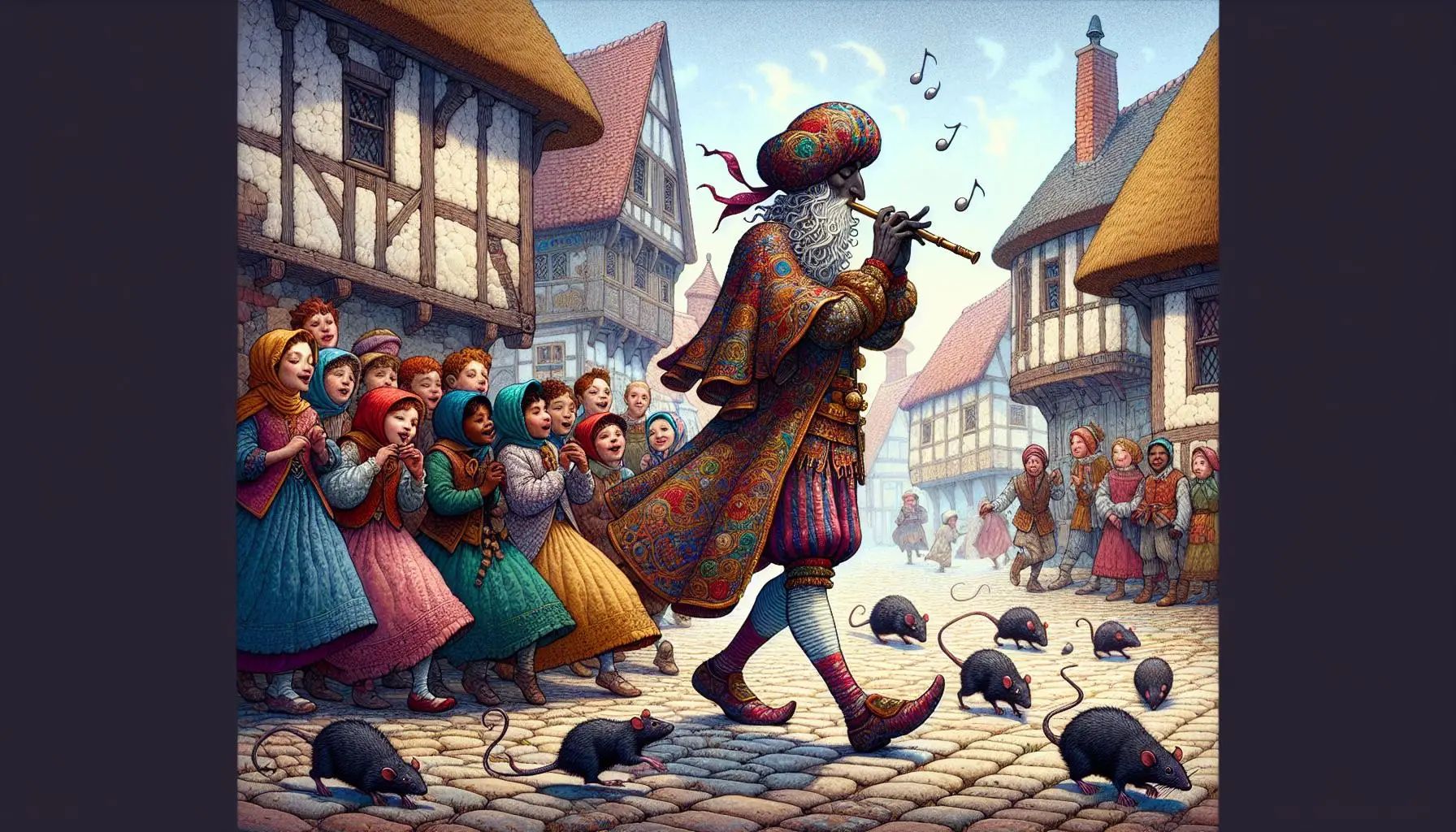The Pied Piper of Hamelin
The Pied Piper of Hamelin is a tale that’s woven itself into the fabric of folklore, captivating audiences with its mysterious allure for centuries. Originating from the picturesque town of Hamelin in Lower Saxony, Germany, this legend has sparked a myriad of interpretations and artistic representations, from murals in San Francisco to classic paintings and postcards from the early 1900s.
At its core, the story represents a figure of enigma and fascination—the Pied Piper, known also as the Rat-Catcher of Hamelin. Some see him as a symbol of hope, a savior who rid the town of a plague-carrying rat infestation, while others ponder the darker undertones of his legend. It’s a narrative that invites curiosity and debate, making it a timeless subject of interest.
The Pied Piper of Hamelin
In my journey to uncover the story behind the Pied Piper of Hamelin, I’ve delved into the intriguing historical context of Hamelin. This town isn’t just a backdrop for a children’s tale; it’s a real place with a rich history that dates back to the Middle Ages. I discovered that Hamelin is located in Lower Saxony, Germany, and was a prosperous town during the 13th century, primarily due to its strategic position on the Weser River which made it a hub for trade.
What captivates me the most is how the legend is deeply interwoven with the town’s identity. Historical records from Hamelin mention a stained glass window in the church, dated back to around 1300, depicting the Pied Piper, signaling the legend’s deep roots in local tradition. This fact alone suggests that the tale of the Piper isn’t merely a fictional story conjured up to entertain or scare children; it was significant enough to be immortalized in sacred architecture.
Moreover, Hamelin’s historical documents allude to a mysterious event in 1284, involving the disappearance of a significant portion of the town’s population. While these records don’t explicitly mention a piper or children, the timing aligns eerily with the narrative of the Pied Piper, adding a layer of mystery and intrigue to the legend.
The synthesis of folklore and history in Hamelin shapes a narrative far more complex and fascinating than I initially thought. It’s not just about a man ridding a town of rats; it’s a story that has survived and morphed through the centuries, reflecting the fears, beliefs, and cultural values of the people of Hamelin.
The tale of the Pied Piper

When diving into the tale of the Pied Piper, I find it to be one of those narratives that doesn’t just captivate but also holds a mysterious allure. At the core, it’s a story about a piper, dressed in multicolored (or “pied”) clothing, who rid the town of Hamelin of rats by enchanting them with his magical flute music, leading them away to their end. However, the intrigue deepens when the townsfolk refuse to pay him for his services. In retaliation, the piper uses his flute to lure the children of Hamelin away, just as he did with the rats, leaving a void in the town that could never be filled.
This narrative has been retold and reimagined countless times across various mediums. Notable adaptations include NBC Studios’ adaptation in 1957 with Van Johnson starring as the Piper and the 1972 British film directed by Jacques Demy. Moreover, the story’s dark undertones were explored in literature, such as Philip Michaels’ horror novel “Come Follow Me” (1983) and animated films like Jiří Bárta’s 1986 adaptation, which presented a more somber version of the tale.
What captures my attention most about this legend is its persistence through centuries and cultures. Its elements of mystery, morality, and loss resonate deeply, reflecting the human condition and the complexities of societal contracts. The varying adaptations, from stop-motion animations to poetic retellings, underscore the timeless relevance and the universal appeal of the Pied Piper’s story. Each iteration invites us to ponder on the consequences of broken promises and the eternal search for justice.
The significance of the rats

In exploring the legend of the Pied Piper of Hamelin, it’s impossible to overlook the symbolic role of the rats. Historically, rats have been associated with disease, destruction, and decay—fears that are deeply ingrained in human societies. My investigation into this part of the tale reveals how these animals not only drive the narrative but also serve as a metaphor for the underlying issues plaguing Hamelin.
Firstly, the rats in this story represent the unchecked problems within the town. Just as rats multiply quickly and overwhelm their environments, the issues in Hamelin—be it societal corruption, broken promises, or communal complacency—have festered to the point of crisis. The town’s inability to control the rat infestation mirrors its failure to address these deeper problems.
Furthermore, rats are agents of retribution. Their overwhelming presence in Hamelin forces the town to confront its inadequacies. In a way, the rats are not the problem but a symptom of larger issues that the townsfolk are too hesitant or too corrupt to tackle. Their reliance on the Pied Piper to rid them of the rats exemplifies a desire for quick fixes rather than sustainable solutions, a theme that resonates in many societal contexts today.
The rats are not just a pestilence to be eradicated but a critical element that sets the stage for the entire narrative. They symbolize the consequences of neglect and the importance of accountability, elements that are as relevant today as they were in the time the legend was first told. By examining the significance of the rats, I gain a deeper understanding of the story’s enduring appeal and the timeless lessons it imparts.
The enigmatic figure of the Pied Piper

Diving deeper into the story of the Pied Piper of Hamelin, we find ourselves captivated by the mysterious and enigmatic figure at its core. The Pied Piper, with his magical pipe and mesmerizing music, has been a subject of intrigue and speculation for centuries. His ability to rid the entire town of rats with nothing but the sound of his pipe paints him as a figure with almost supernatural abilities. But what truly makes him enigmatic is not just his magical prowess, but also the moral ambiguity of his actions.
On one hand, the Pied Piper appears as a savior to the townsfolk, offering a much-needed solution to the rat infestation that had plagued them. His success, achieved without any apparent effort, indicates not only his unique skill but also raises questions about the nature of his powers. Was he merely a skilled piper, or did he possess some otherworldly gift? This ambiguity adds layers to his character, making him a figure of both admiration and fear.
However, the turn of events following the town’s refusal to pay him the promised sum reveals a more vengeful side to his character. His decision to lure away the children of Hamelin speaks to a deeper desire for justice or perhaps retribution. It suggests that his actions, while seemingly whimsical, are driven by a strict code of fairness and a refusal to be deceived or undervalued.
As I delve into the legend, I’m struck by the dual nature of the Pied Piper – a figure who operates at the intersection of hero and villain. His story encourages us to ponder the complexities of justice, retribution, and the consequences of not honoring one’s promises. Through his actions, we’re reminded of the importance of accountability, and the potentially dire outcomes of failing to recognize and reward the contributions of others.
Interpretations and symbolism
Delving into the rich tapestry of The Pied Piper of Hamelin, I’ve always been fascinated by the layers of interpretations and symbolism that this story offers. At its core, the tale is not just about a man who led away rats and then children; it’s a narrative steeped in cautionary elements, morality, and deep, symbolic meanings that resonate across ages.
One predominant interpretation of the Pied Piper story centers on the theme of betrayal and its consequences. The town’s failure to honor its agreement with the Pied Piper symbolizes a breach of trust and the moral obligations inherent in social contracts. This aspect of the story cautions against the perils of not fulfilling promises, suggesting that the price of dishonesty can be far greater than one imagines.
Furthermore, the Pied Piper himself is a complex symbol. To me, he embodies the dual nature of being both a savior and a destructor. Initially, he appears as the solution to the town’s rat infestation, a hero of sorts. However, his transformation into a figure of retribution illustrates the darker side of justice, where the lines between right and wrong blur.
Another layer of symbolism I find intriguing is the representation of the children. In many interpretations, they symbolize innocence and purity, led astray by the failure of the adults around them to act responsibly. This dimension of the story underscores the impact of adult actions on younger generations and the importance of safeguarding their well-being.
From these interpretations, The Pied Piper of Hamelin emerges not just as a simple folktale but as a narrative rich with symbolism and moral questions. It’s a story that invites us to ponder the complexities of human nature, justice, and the consequences of our actions.
Conclusion
The Pied Piper of Hamelin isn’t just a tale of magic and mystery; it’s a narrative that has woven itself into the fabric of folklore, urging us to reflect on our moral compass and the repercussions of our decisions. Through its rich symbolism and multifaceted characters, it challenges us to consider the fine line between right and wrong and the importance of fulfilling our promises. As we delve into the darker corners of this legend, we’re reminded of the impact our actions can have on future generations and the significance of accountability. Whether viewed as a hero or a villain, the Pied Piper’s story is a compelling reminder of the complexities of human nature and justice. It encourages us to ponder not just the tale itself but also its relevance in today’s world, making it a timeless piece that continues to captivate and provoke thought.
Steve is the creative force behind My Unique Tales, a blog dedicated to sharing captivating stories that explore the human experience in all its complexity. With a passion for writing and a talent for crafting engaging narratives, Steve's blog is a treasure trove of imaginative tales that transport readers to other worlds and challenge them to see things from new perspectives. From epic adventures to intimate character studies, Steve's stories are always thought-provoking and emotionally resonant. With a growing following of readers who appreciate his unique voice and creative vision, Steve is quickly becoming a rising star in the world of online storytelling.






